The Rule of Thirds is essential for smartphone photography because it helps you create more balanced and visually appealing images. By dividing your frame into a 3×3 grid, you can place key elements along the lines or at intersections, enhancing composition and viewer engagement. This technique works wonders for landscapes, portraits, and various subjects, allowing you to effectively use negative space and create dynamic focal points. Most smartphones offer built-in grid lines, making it easy to apply this principle on the go. Mastering the Rule of Thirds will transform your smartphone shots from ordinary to extraordinary, but there's much more to explore in the world of mobile photography composition.
Understanding the Rule of Thirds

Diving into the core of smartphone photography composition, the Rule of Thirds is a fundamental principle that can dramatically improve your images. This guideline suggests dividing your frame into a 3×3 grid, creating nine equal sections. The key is to place your main subject along these lines or at their intersections, rather than centering it.
You'll find that most smartphones have a built-in grid feature you can enable in your camera settings. This overlay makes it easy to visualize the Rule of Thirds while shooting. By positioning important elements along these lines, you'll create more balanced and visually appealing photos.
The Rule of Thirds works because it aligns with how our eyes naturally scan an image. It creates a sense of movement and interest, drawing the viewer's gaze across the entire frame.
When you're photographing landscapes, try placing the horizon on the upper or lower third line. For portraits, position your subject's eyes near an intersection point.
Activating Grid Lines on Smartphones
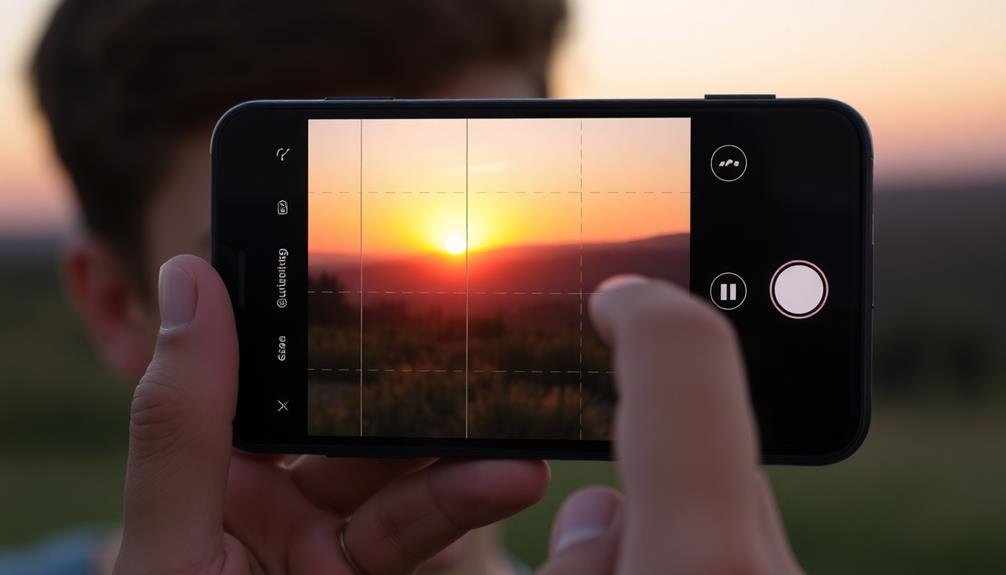
Now that you understand the Rule of Thirds, let's explore how to activate grid lines on your smartphone. Most modern smartphones have a built-in option to display a grid overlay on your camera screen. This feature divides your frame into nine equal parts, making it easier to compose your shots according to the Rule of Thirds.
To activate grid lines on your iPhone, go to Settings > Camera > Grid. For Android devices, open your Camera app, tap the gear icon, and look for the "Grid lines" option. Once enabled, you'll see two horizontal and two vertical lines on your screen, creating a 3×3 grid.
Here are some benefits of using grid lines:
- Improved composition and balance in your photos
- Easy alignment of subjects along the intersecting lines
- Better placement of horizon lines in landscape shots
- Assistance in keeping your images straight and level
- Enhanced creativity by encouraging unconventional framing
With grid lines activated, you'll find it much easier to apply the Rule of Thirds to your smartphone photography.
Practice placing your main subjects along the lines or at their intersections. As you become more comfortable with this technique, you'll notice a significant improvement in the overall quality and impact of your photos.
Balancing Elements in Your Shots
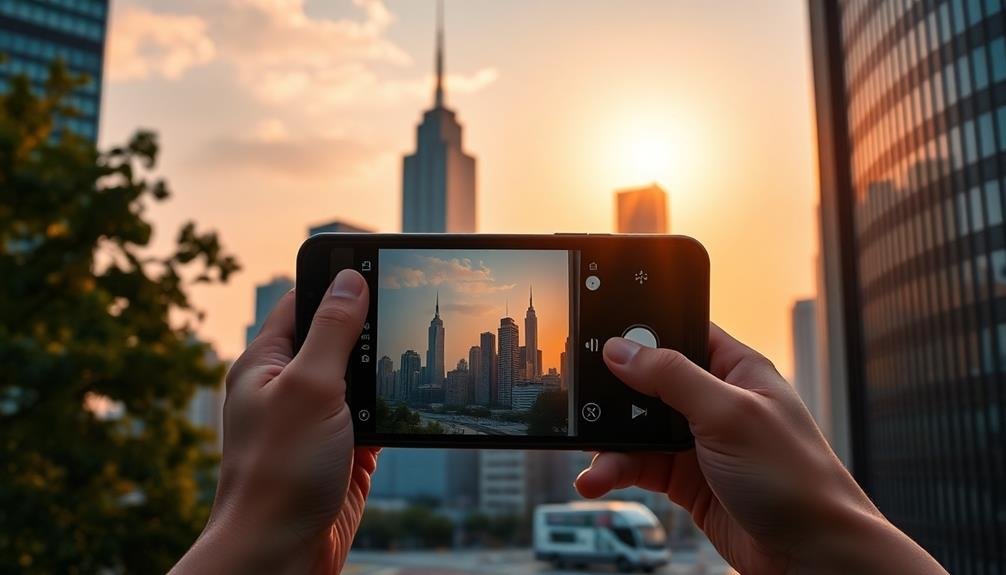
When composing your smartphone photos, you'll need to decide whether to place your subject in the center or off-center.
Utilizing negative space effectively can create a sense of balance and draw attention to your main subject.
Center vs. Off-Center Subjects
Composing shots with center vs. off-center subjects is a key consideration when applying the rule of thirds. When you place your subject in the center, it can create a sense of symmetry and stability. However, this approach often results in static, less engaging images.
By positioning your subject off-center, you'll create a more dynamic and visually interesting composition that draws the viewer's eye through the frame. To effectively use off-center subjects, align them with the intersection points of your rule of thirds grid. This technique adds depth and balance to your photos, making them more appealing and professional-looking.
Remember, you don't always have to follow this rule strictly; sometimes, breaking it intentionally can lead to striking results.
Consider these factors when deciding between center and off-center subjects:
- The story you want to tell with your image
- The surrounding environment and background elements
- The subject's size and orientation
- The direction of movement or gaze
- The overall mood you're trying to convey
Experiment with both centered and off-center compositions to develop your eye for balance and visual interest. With practice, you'll intuitively know when to use each approach to create compelling smartphone photos.
Negative Space Utilization
Alongside the rule of thirds, mastering negative space utilization is essential for creating balanced and impactful smartphone photos. Negative space refers to the empty areas surrounding your main subject, and it's vital for adding depth and focus to your images.
When you're composing your shot, pay attention to the areas around your subject. Use these empty spaces to draw attention to your focal point and create a sense of balance. You can achieve this by positioning your subject off-center and allowing the negative space to occupy a larger portion of the frame.
Experiment with different ratios of negative space to subject. A 2:1 or even 3:1 ratio can create a striking, minimalist effect that emphasizes your subject. Don't be afraid to leave large areas of your frame empty – this can create a sense of isolation or vastness that adds emotional impact to your photos.
Remember that negative space doesn't have to be completely blank. It can include subtle textures, gradients, or out-of-focus elements that complement your subject without competing for attention.
Creating Visual Interest
Creating visual interest in your smartphone photos goes beyond simply applying the rule of thirds and utilizing negative space.
It's about balancing elements to draw the viewer's eye and create a compelling composition. You'll want to evaluate the interplay between different objects, colors, and textures in your frame.
To achieve this balance, focus on:
- Contrasting elements (light vs. dark, smooth vs. rough)
- Leading lines that guide the viewer's gaze
- Symmetry or asymmetry, depending on your desired effect
- Repetitive patterns or shapes
- Complementary or contrasting colors
When composing your shot, think about how each element contributes to the overall story you're trying to tell.
Don't be afraid to experiment with different angles or perspectives to find the most interesting composition. You can also use foreground elements to add depth and frame your main subject.
Creating Visual Interest and Appeal
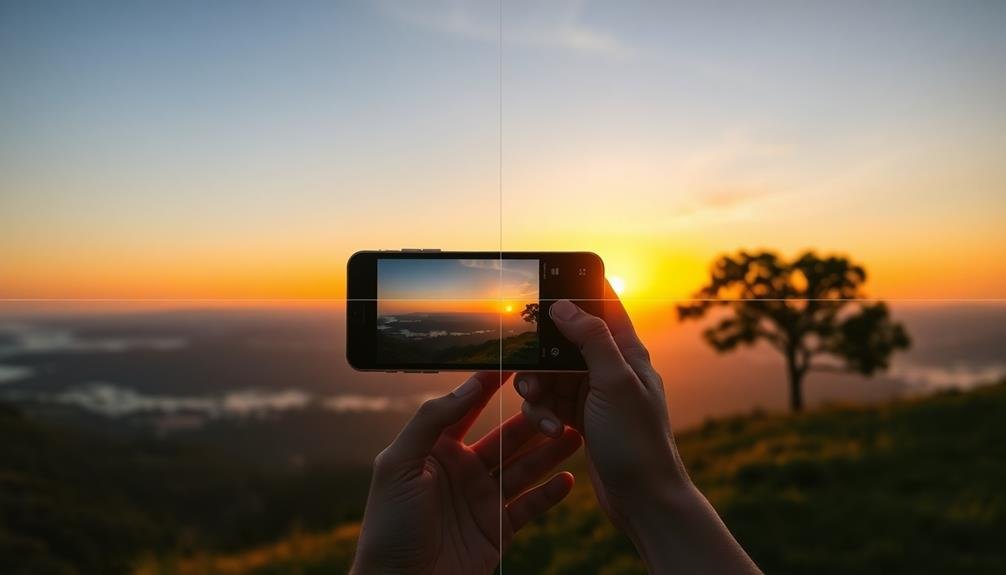
The rule of thirds can breathe life into your smartphone photos by creating visual interest and appeal. By dividing your frame into a 3×3 grid and placing key elements along these lines or at their intersections, you'll instantly make your images more engaging. This technique draws the viewer's eye to specific points, creating a sense of balance and harmony.
You'll find that off-center compositions often look more dynamic than centered ones. Place your main subject slightly to the side, and you'll create a more natural, flowing image. This approach also leaves space for the viewer's eye to explore the rest of the frame, adding depth to your photo.
When capturing landscapes, try aligning the horizon with the upper or lower third line. This emphasizes either the sky or the foreground, depending on which is more interesting.
For portraits, position your subject's eyes along the upper third line to create a more compelling image.
Enhancing Landscape Photography Compositions

When capturing landscapes with your smartphone, you'll want to reflect on three key aspects of the rule of thirds.
Start by balancing the sky and ground in your composition, typically allocating two-thirds to the more interesting element.
Next, use the grid to position leading lines, guiding the viewer's eye through the scene.
Balancing Sky and Ground
Landscape photographers often face the challenge of balancing sky and ground elements in their compositions. The rule of thirds can be your secret weapon for achieving this balance. By dividing your frame into a 3×3 grid, you'll create natural guidelines for placing key elements.
When capturing landscapes, consider positioning the horizon along one of the horizontal lines. If the sky is dramatic, place it along the bottom third line to give it more prominence. For scenes with interesting foreground elements, align the horizon with the top third line.
Here's how the rule of thirds helps balance sky and ground:
- Creates visual harmony between upper and lower portions
- Prevents the image from feeling top or bottom-heavy
- Guides the viewer's eye through the composition
- Adds depth and dimension to flat landscapes
- Allows for creative placement of focal points
Leading Lines Placement
Four powerful ways to enhance your landscape compositions involve strategically placing leading lines. When you're framing your shot, look for natural or man-made lines that draw the eye into the image. These could be roads, fences, rivers, or even patterns in the sand. Place these lines along the grid points or lines of your rule of thirds overlay to create a dynamic and engaging composition.
You'll want to experiment with different angles and perspectives to maximize the impact of your leading lines. Try positioning them diagonally across the frame for a sense of movement, or use converging lines to create depth and draw attention to a focal point.
Here's a quick guide to help you place leading lines effectively:
| Line Direction | Effect | Best Use |
|---|---|---|
| Horizontal | Calm, stable | Horizon, beaches |
| Vertical | Strong, powerful | Trees, buildings |
| Diagonal | Dynamic, energetic | Mountains, roads |
Focal Point Positioning
Focusing on the heart of your landscape composition, focal point positioning plays an essential role in creating visually striking images. When you're capturing a landscape with your smartphone, identifying and positioning the main subject is vital. This focal point draws the viewer's eye and provides a sense of purpose to your photo.
To effectively position your focal point using the rule of thirds, imagine your screen divided into a 3×3 grid. Place your main subject at one of the intersecting points of these lines. This creates a more dynamic and engaging composition than centering your subject.
Consider these tips for focal point positioning in landscape photography:
- Use natural elements like trees, rocks, or buildings as focal points
- Position a person or animal at one of the intersecting points for scale
- Incorporate leading lines that guide the eye to your focal point
- Experiment with negative space to emphasize your subject
- Use contrasting colors or textures to make your focal point stand out
Improving Portrait Photography Techniques

When it comes to portrait photography, mastering the rule of thirds can dramatically improve your shots. By placing your subject's eyes along the upper horizontal line or at one of the intersecting points, you'll create a more engaging and balanced composition.
Don't always center your subject; instead, try positioning them slightly off-center to add visual interest and draw the viewer's eye through the frame.
Use the rule of thirds to guide your background composition as well. Place interesting elements along the grid lines or at intersection points to create depth and context.
When capturing full-body portraits, align the subject's body with a vertical line, leaving space for them to "look into" the frame.
Experiment with negative space by positioning your subject along one of the vertical lines, leaving two-thirds of the frame open. This technique can create a sense of scale or isolation, depending on your intended mood.
Remember to pay attention to the background, ensuring it complements rather than distracts from your subject. By consistently applying the rule of thirds, you'll develop an intuitive sense of composition that will elevate your smartphone portrait photography.
Applying Rule to Different Subjects

The rule of thirds isn't limited to portrait photography; it's a versatile principle that can enhance various subjects in your smartphone shots. You can apply this technique to landscapes, street scenes, still life, and even abstract compositions.
When photographing landscapes, try placing the horizon along one of the horizontal third lines. For cityscapes, align tall buildings or prominent structures with vertical third lines to create a balanced composition.
In street photography, position your main subject at one of the intersection points to draw attention and create visual interest. For still life shots, arrange your objects along the grid lines or at the intersections to achieve a pleasing composition.
Even when capturing abstract scenes, use the rule of thirds to guide the placement of dominant shapes, colors, or textures.
Here are some subjects where you can effectively apply the rule of thirds:
- Nature scenes (flowers, trees, animals)
- Architecture and buildings
- Food photography
- Product shots
- Action and sports photography
Breaking the Rule Effectively
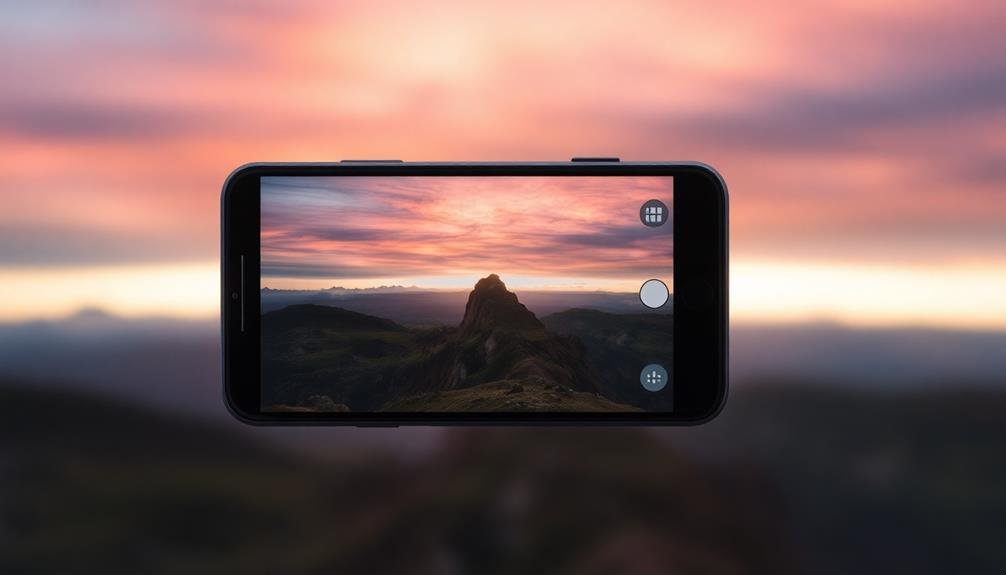
While the rule of thirds can greatly improve your smartphone photography, it's not a rigid law. Knowing when to break this rule can lead to even more compelling images. You'll find that certain compositions benefit from deliberately ignoring the rule of thirds.
Centered compositions can create a sense of symmetry and balance, which works well for reflections, portraits, or architectural shots. Placing your subject in the middle of the frame can also emphasize its importance or create a more confrontational image.
For dramatic effect, try positioning your subject at the very edge of the frame. This unconventional approach can create tension and draw the viewer's eye across the entire image. It's particularly effective for landscape shots or when capturing movement.
Diagonal compositions can add dynamism to your photos. Instead of aligning elements along the thirds, experiment with diagonal lines that cut across the frame. This technique works well for cityscapes or when photographing stairs or roads.
Editing With Rule of Thirds

Editing with the rule of thirds doesn't end when you've taken the shot. Many smartphone photo editing apps offer grid overlays that allow you to apply the rule of thirds during post-processing. This feature enables you to crop and reframe your images to enhance their composition and visual impact.
When editing, consider these key points:
- Align horizon lines with horizontal grid lines
- Position main subjects at intersections of grid lines
- Use negative space to create balance
- Crop to emphasize leading lines
- Adjust contrast to draw attention to specific areas
By applying the rule of thirds during editing, you can transform mediocre shots into compelling images.
Experiment with different crops to find the most visually appealing arrangement. Don't be afraid to move your subject off-center or create asymmetry for added interest.
Frequently Asked Questions
Can the Rule of Thirds Be Applied to Video Recording on Smartphones?
Yes, you can apply the rule of thirds to smartphone video recording. It'll help you create balanced and visually appealing compositions. Use your phone's grid feature to align subjects and points of interest along the intersecting lines.
How Does the Rule of Thirds Interact With Other Composition Techniques?
You'll find the rule of thirds interacts harmoniously with other composition techniques. It can complement leading lines, frame subjects effectively, and enhance symmetry. You're able to combine it with various methods for more dynamic and engaging images.
Are There Cultural Differences in Perceiving Images Composed Using This Rule?
You'll find that cultural perceptions of rule-of-thirds compositions can vary. While it's widely accepted in Western art, some cultures may prefer centered or asymmetrical layouts. It's important to contemplate your audience when applying this technique globally.
Does the Rule of Thirds Work Equally Well for All Smartphone Camera Lenses?
You'll find the rule of thirds works well for most smartphone lenses, but it's not a one-size-fits-all solution. Wide-angle and telephoto lenses might require slight adjustments to achieve the best composition for your shots.
How Can Ai-Powered Smartphone Cameras Incorporate the Rule of Thirds Automatically?
AI-powered smartphone cameras can automatically apply the rule of thirds by detecting key elements in your frame. They'll overlay a grid, suggest composition adjustments, and even crop images to align with this principle, enhancing your photos effortlessly.
In Summary
You've now got the tools to elevate your smartphone photography using the rule of thirds. Remember, it's not a strict law but a guideline to help you create more engaging images. As you practice, you'll develop an intuitive sense of composition. Don't be afraid to experiment and break the rule when it serves your creative vision. With time, you'll capture stunning photos that draw viewers in and tell compelling visual stories.



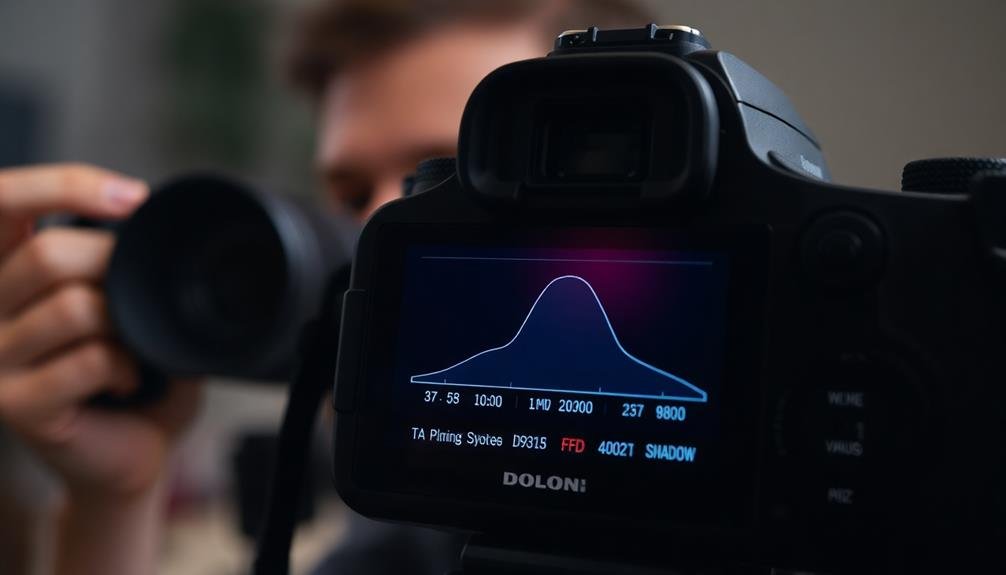
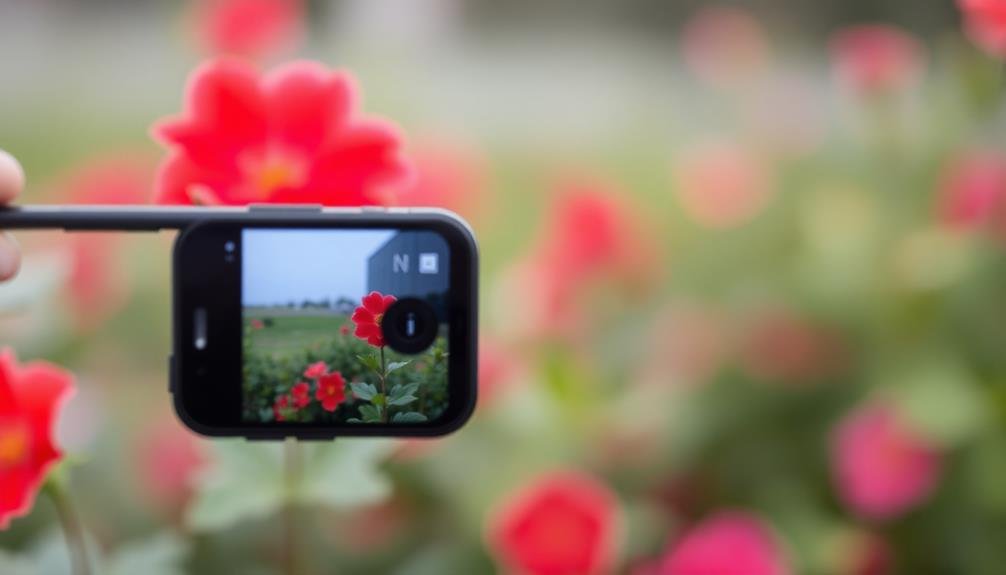
Leave a Reply